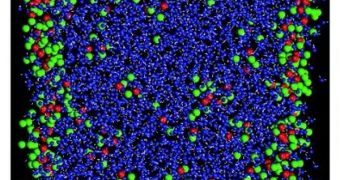In an interesting, new development, scientists have demonstrated for the first time that strontium ions congregate on the surface of water. The behavior of this type of ions, which are, in fact, divalent cations (two electrons missing), has been a subject for scientific debate until now, because theoretical models and practical studies did not match conclusions. The new investigation has proven, through a computer model and complicated calculations, that strontium indeed seems to float on the surface of water, PhysOrg reports.
The three researchers that have been in charge of the new investigation came from the US Department of Energy's (DOE) Pacific Northwest National Laboratory (PNNL) and the Louisiana Tech University (LTU). A scientific technique known as X-ray reflectivity was used to demonstrate the behavior of the ions on top of water. Conventional wisdom until now had it that cations had to flee the surface of the water, but the new study has proven exactly the contrary. In charge of the study have been PNNL postdoctoral fellow Dr. Xiuquan Sun, PNNL scientist Dr. Liem Dang, as well as Dr. Collin Wick, from the LTU.
The investigation bears considerable implications for the field of chemical-reaction analysis. These interactions form the basis of the world around us, and a deeper understanding of ionic behavior can give researchers new insight into predicting, and eventually controlling, new types of reactions. The study was made all the more interesting by the fact that measurement results seemed to contradict theoretical models from the get-go. The ions that were studied came from strontium chloride (SrCl2) dissolved in water, the team reports.
Although the team's model is able to accurately predict that cations prefer the surface of the water, it is far from perfect. For instance, at low ionic concentrations, it's able to predict the amount of ions that will congregate on the surface, whereas, at higher concentrations, it overestimates the surface concentrations by a factor of 2. Details of the investigation appear in a paper entitled “Computational Studies of Aqueous Interfaces of SrCl2 Salt Solutions,” published in the latest issue of the Journal of Physical Chemistry B.

 14 DAY TRIAL //
14 DAY TRIAL //